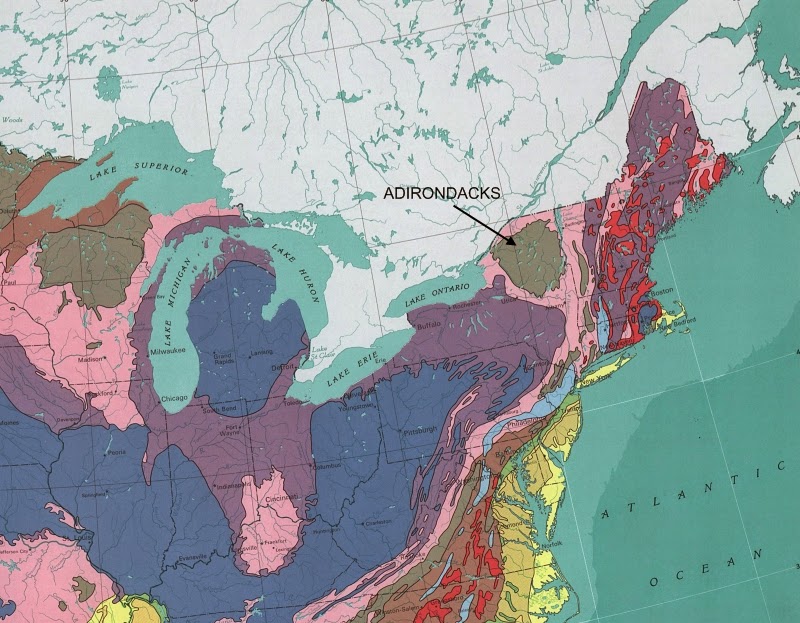We’ve talked this month about the abundance of life in the Devonian – the spreading of plants across the land, and even the first forests. Both diversity and abundance resulted in oil and natural gas source systems that add up to one of the largest in all of geologic history. It all came to a rather screeching halt with two major extinction events toward the end of the Devonian.
The first occurred before the end of the period, at the boundary between the last two subdivisions of Devonian time, the Frasnian and Fammenian stages, at about 374 million years ago. A second event took place at the end of the Devonian, about 359 million years ago.
Together these two events wiped out something like 75% or more of all species – some estimates say as much as 87%. Depending on how you look at it – diversity, abundance, marine, non-marine, the end Devonian extinctions might be second to the end Permian extinction, but in any case, the end of the Devonian is one of the “big five” mass extinctions in earth history.
It’s quite clear that the extinctions were associated closely with anoxic periods in the world’s oceans – times when the oxygen content of the water decreased drastically. That gives us a starting point for trying to determine the causes.
One possibility is climate change. You may recall that western Gondwana was situated over the south pole during much of the Devonian, but there’s not much evidence for glaciation until late in the period. A Late Devonian glacial epoch would have decreased sea level, and as we’ve heard in previous extinctions, that reduces shallow water niches for life as well as cooling the average water temperature. Life that lives in warm, shallow, well-oxygenated water suffers.
Another possibility is that all the life on land – plants including trees, for the most part – would have resulted in a dramatic increase in the volume of nutrients washing from the land into rivers and ultimately into the sea. Enough nutrients could have led to immense algal blooms that could have produced eutrophication – stagnation – in shallow or restricted seas.
Plants on land would have accelerated chemical weathering of rocks as they form soil. By burying organic matter, it would have been a form of carbon sequestration, and reducing carbon dioxide in the atmosphere would have reduced the greenhouse effect and resulted in cooling. That in turn might be tied to the glaciation, or the glaciation might have begun for some other reason such as changes in the earth’s orbit, but it might have been accelerated by the removal of CO2 from the atmosphere by land plants.
There’s some speculation that an impact or impacts from an asteroid or other bolide might have triggered, or at least contributed to, the climatic effects that resulted in extinctions, but even though there are a couple known impacts at about the right time, they really don’t seem to have been big enough to have had the dramatic effects that are observed in the fossil record. Nor would meteoric impacts have necessarily produced the global oceanic anoxia that we know was present and the timing isn’t really right, either.
The anoxic conditions contributed to the organic-rich black shales we’ve talked about this month, so to an extent, the extinctions that led to trapping of organic matter in the rocks helped generate some important oil source rocks.
All the phyla that we have today survived the extinctions in the Late Devonian, but several sub-groups did not. The arthrodires, the huge predatory fish, went extinct, and so did the primitive armored fish, placoderms and ostracoderms. Corals suffered badly and while most groups survived, abundance decreased so that reef-building pretty much ceased and there were no substantial reef ecosystems for the next 100 million years.
The late Devonian extinctions seem to have clearly come in at least two distinct pulses, each one lasting a million years or so, but as more information has become available, it is also looking like the “events” might have been the culminations of a longer period of crisis for life that spanned as much as 15 million years. To my mind, it’s much easier to explain things like this when they are gradual, since changes like the oceans becoming anoxic and the atmosphere losing carbon dioxide would be expected to take time. With some exceptions, of course. Catastrophes CAN happen. But it seems to me that the end Devonian extinctions probably result from changes that took a lot more time than something like a cosmic impact, and that they came about from multiple, interconnected causes.
* * *
On this day, May 31, 1970, an earthquake in Peru killed more than 67,000 people, perhaps as many as 100,000. It was a subsea quake just off the northern coast of Peru, but there was no tsunami. The death toll was mostly the result of a landslide and avalanche in the mountains that took ice, rock, water, and debris 11 miles down a river valley to bury several towns beneath as much as 80 million cubic meters of material. The quake was related to the subduction of the Nazca Plate – part of the oceanic crust beneath the Pacific Ocean – and the South American continental plate. It was part of the process that continues to build the Andes Mountains.
—Richard I. Gibson
Link:
British Natural History Museum






















